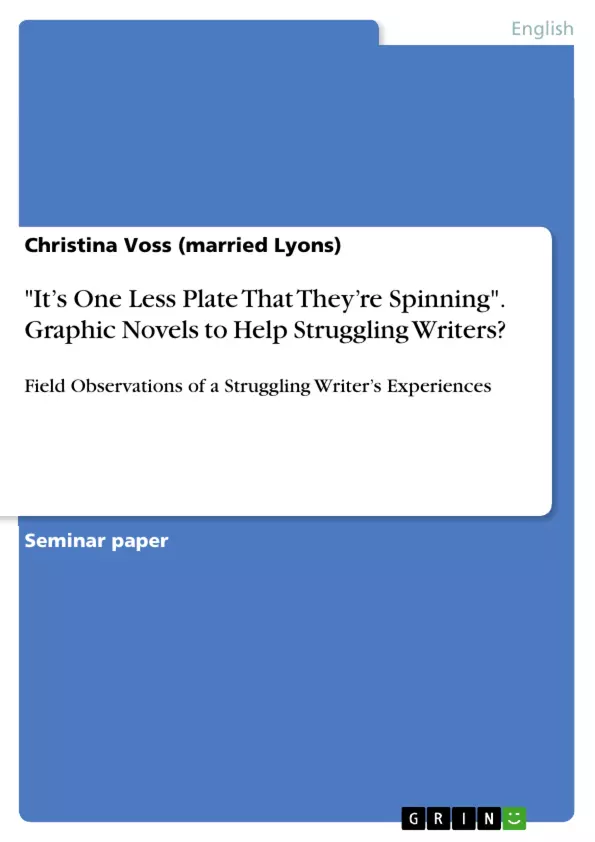In the history of teaching, different kinds of visual literacies could be shown beneficial for students; it need not be a whole novel rendered in pictures, it can start with simple letter recognition. The present study will deal with a struggling writer's experiences with graphic novels.
My single case study participant is a 6th-grade, male struggling writer of African descent, born in the U.S. He is not professionally diagnosed, but has an IEP at his middle school for "executive function disorder," which officially does not exist as a "disease." His teachers have noticed that he has trouble executing written tasks, although he is perfectly able to dictate content of high quality. It seems to be not only a graphomotor dysfunction, for he can type a little better than handwrite; the main problem for him is to start a writing task, and also to finish it. As preliminary data from a year-long tutoring experience in a local Reading Clinic revealed, during which time I worked with him first in a classroom environment for half a year, and then in my office with just two tutees present, the boy reads at 9th grade level; however, when asked to do a quickwrite in 10 minutes, he can only come up with sentences like, "Can I have a drink please?", whereas the other tutees managed to write half a page or a page of a story. His handwriting is huge, uneven, bears mechanical errors (although not enough to call him dyslexic for his age category), and so slow-paced that he cannot manage to finish a task in a given time. In clear opposition to this stands the observation that Remy has an astonishingly advanced vocabulary; when talking to him, one thinks he is much older and more mature, and very polite and well-behaved. This impression fades when one tutors him, and he exhibits unsuppressed, child-like behavior like farting and belching without embarrassment.
The other participants are 28 teachers / professors who use graphic novels and took an online survey; 2 high school English teachers who do not use graphic novels and were interviewed personally; 20 authors and illustrators, as well as scholarly reviewers of graphic novels who took their respective online surveys.
Inhaltsverzeichnis (Table of Contents)
- New and Hidden Literacies: Why Teach With Pictures?
- The Supermen and Superwomen: My Participants
- The Super Weapons: My Methods
- The Super Story: My Results
- Teachers' Perceptions
- Authors'/Illustrators' Perceptions
- Field Observations: "There's nothing to be written in this text field-here, we would have sound!"
- Conclusion
Zielsetzung und Themenschwerpunkte (Objectives and Key Themes)
This study investigates the use of graphic novels as a tool to help struggling writers, particularly focusing on the experiences of one student. It examines the potential benefits of visual literacy in education, particularly for students who are "picture-smart." The study explores the role of graphic novels in engaging students, developing literacy skills, and fostering critical thinking.
- The potential of graphic novels to engage struggling writers
- The role of visual literacy in education
- The importance of addressing "hidden literacies" in students
- The effectiveness of graphic novels in promoting critical thinking and media literacy
- The potential of visual literacy to support learning in various content areas
Zusammenfassung der Kapitel (Chapter Summaries)
- New and Hidden Literacies: Why Teach With Pictures? This chapter provides an overview of the concept of "hidden literacies" and explores how visual literacy can be leveraged in education, particularly for students who are "picture-smart." It references research on the benefits of visual learning across different content areas and discusses the potential of graphic novels to engage students and foster their literacy development.
- The Supermen and Superwomen: My Participants This chapter introduces the participants in the study and provides background information about them. It likely describes the characteristics of the student who is the focus of the study, as well as the teachers and graphic novel authors/illustrators who are involved in the research.
- The Super Weapons: My Methods This chapter outlines the methodologies employed in the study. It likely discusses the research design, data collection methods, and the specific approaches used to gather information from participants.
- The Super Story: My Results This chapter presents the findings of the study, focusing on the experiences of the struggling writer student. It explores the impact of graphic novels on the student's engagement, writing skills, and overall literacy development. It likely includes data from the student's reflections, observations by the teacher, and perspectives from the authors/illustrators of the graphic novels.
Schlüsselwörter (Keywords)
The study focuses on graphic novels, visual literacy, struggling writers, "hidden literacies," multiple intelligences, and the potential benefits of incorporating visual learning strategies in education. The research delves into the use of graphic novels as a tool to engage students, promote critical thinking, and enhance literacy development.
- Quote paper
- Dr. Christina Voss (married Lyons) (Author), 2010, "It’s One Less Plate That They’re Spinning". Graphic Novels to Help Struggling Writers?, Munich, GRIN Verlag, https://www.grin.com/document/1132999



